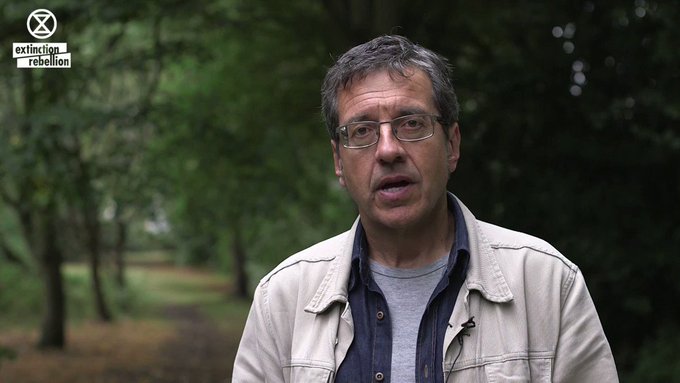October 8th, 2019
Environmental protesters scored a major coup on October 7 in Vancouver. Their climate demonstration managed to lead all the late-night newscasts.
It’s because the Vancouver chapter of Extinction Rebellion peacefully blocked the Burrard Bridge to traffic all day and evening.
This was the group’s first major direct action in Vancouver and it was part of an “International Week of Rebellion” for the climate in more than 60 cities.
Ten people were arrested in Vancouver. When some were taken away, their bodies went limp.
In this way, they appeared as martyrs for the climate in the eyes of some TV viewers.
According to Extinction Rebellion Vancouver spokesperson Grace Grignon, this event took months of preparation and workshops were held to train protesters in peaceful civil disobedience.
Research underscores Extinction Rebellion's tactics
Extinction Rebellion was created last year in the U.K. by former organic farmer Roger Hallam and former scientist Gail Bradbrook.
They’ve studied the history of protests and believe that mass peaceful disobedience is the best way to bring about a societal transformation.
“According to research on conflicts between non-state and state actors around the world between 1900 and 2006, it was found that 53% of nonviolent campaigns were successful as opposed to 26% of campaigns that used violence,” the Extinction Rebellion website states. “Moreover, of the violent campaigns, 95% had descended into dictatorship or totalitarian rule within five years.”
The group is motivated by the research of Harvard political scientist Erica Chenoweth. She found that it only takes about 3.5 percent of the population to be involved in protests to bring about large-scale political changes.
The objective is to attract “upstanders” who feel compelled to join a movement.
That's at the root of the message below by widely respected Guardian columnist George Monbiot.
“Business as usual... is not going to get us out of this... mess. We need system change... that requires... non-violent civil disobedience... and that's why on October 7th I'm joining... #ExtinctionRebellion”, @GeorgeMonbiot.
We need #EverybodyNow: https://rebellion.earth/international-rebellion/ …See video at link.
Discomfort elevates understanding
To try to maintain the moral high ground, Extinction Rebellion gives advance notice of its street protests so people can plan alternative routes.
The group will allow ambulances to pass through protests, if necessary. But it has no concerns about inconveniencing transit operators to get its message across about the urgency of the climate crisis.
In Vancouver on Monday (October 7), some motorists and transit users certainly were inconvenienced. That was most apparent in a fairly massive late afternoon and early evening traffic jam for northbound passengers on the Granville Bridge and Seymour Street exit entering downtown Vancouver.
The Number 2 bus, which ordinarily cruises westbound over the Burrard Bridge, was snarled in gridlock on a southbound Granville Bridge off-ramp to West 4th Avenue.
It was a visceral message to these people that the status quo no longer exists.
If people turned on their vehicle radios, they learned that there’s a climate rebellion underway. That’s precisely what the Extinction Rebellion protesters were hoping to achieve. And that was reinforced by the late-night newscasts, which made the climate the top story.
Even the name, Extinction Rebellion, conveys the gravity of the climate crisis in ways that the names of other environmental organizations—Greenpeace, Pembina Institute, Dogwood Institute, and Sierra Club—can never do.
"Extinction Rebellion" implies that the people on the bridge were fighting for the survival of the human species in the face of potentially catastrophic rises in greenhouse gas emissions.
Even if people disagreed with their methods, it would be hard to question the motivations that drove them to do this.

Extinction Rebellion wants Citizens' Assembly
Extinction Rebellion’s demands are straightforward and it maintains that they are rooted in the scientific truth of the climate crisis.
It says, first of all, that governments have failed to protect the public in the face of an unprecedented global emergency.
Therefore, governments must begin by telling the truth about the climate and the wider ecological emergency. This includes reversing inconsistent policies and working alongside the media to communicate with citizens and communities.
Secondly, governments must enact legally binding policy measures to reduce carbon emissions to net zero by 2025 and reduce consumption levels. Thirdly, Extinction Rebellion is calling for a national Citizens’ Assembly to oversee the changes.
So why launch a climate rebellion in the first place? Activists will point out that under current increases in emissions, Earth is on track for a nearly 4 ° C average temperature rise this century over the pre-industrial period.
That would cause deadly heat waves that could kill millions, promote more devastating wildfires, and trigger food shortages that could lead to the breakdown of societies.
This temperature rise doesn’t even account for the possibility of climate feedback loops kicking in, such as the release of massive amounts of carbon stored in warming oceans. All of this could conceivably come together to lead to the extinction of the human species.
According to the UN’s Intergovernmental Panel on Climate Change, there’s still time to take action to turn this situation around. Extinction Rebellion argues that to date, governments have been utterly negligent, justifying a popular uprising.
"Why 2020 is a key year for climate action" by @CarolynBeeler for @PRI @PRITheWorld:https://www.pri.org/stories/2019-09-17/why-2020-key-year-climate-action …
The recent shutdown of the Burrard Bridge is only the beginning. I suspect that in the months and years to come, there will be many more protests like this and many, many more arrests.
Large-scale civil disobedience will likely take place in the future in downtown Vancouver, on other bridges, and at Vancouver International Airport and local conventions of greenhouse-gas-emitting industries.
Theatrical public "die-ins" can be expected outside and possibly inside legislative chambers. The medical community will be mobilized, as will seniors and children.
That's because Extinction Rebellion has such a compelling message and offers a means for people to take action.
It's only just begun.






